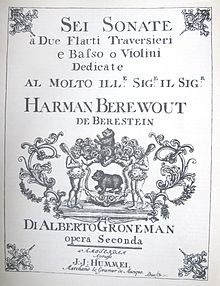Albertus Groneman
Albertus Groneman , also Johann Albert Heinrich Groneman (baptized December 6, 1711 in Hamm ; buried June 1, 1778 in The Hague ) was a Dutch composer of German descent.
Life
Johann Albert Heinrich Groneman came from a Westphalian family and came to the Netherlands around 1730. On February 11, 1732 he was enrolled as a musician at the University of Leiden . Before 1734 Groneman married Wijntje van Arkel and settled as a composer in The Hague between 1736 and 1742. In 1742 he was given the position of carillon player at the Grote or St. Jakobskirche , where he was appointed organist a year later. Even before his appointment in The Hague, he had made a name for himself as a violin virtuoso. After his wife died in 1751, he suffered from a nervous disease around the middle of the decade, during which time his valuable collection of instruments was auctioned. A little later, Groneman reappeared as a musician and married a second time in 1758. Gronemann died in 1778 and was buried on June 1st of that year in the Grote Kerk in The Hague.
siblings
In addition to Albert Groneman, other family members followed him to the Netherlands, including Johan Frederic Groneman and Anton Groneman, both composed works for violin or flute. The sister Christina Maria (1706 to after 1750) was married to the musician Giuseppe Avoglio and was known as Signora Avoglio in the circle of Georg Friedrich Handel . Before that she sang in Hanover, Moscow, Saint Petersburg, Brussels, Hamburg and Prague, among others. Sibylla Groneman, born in 1720, sang in London in Singspiele by Thomas Arne and Johann Friedrich Lampe as well as in Handel's oratorios. She was married to the violinist Thomas Pinto (1728–1783). Other siblings were active as Dutch military musicians.
plant
His collections of flute sonatas were published by the London publisher Walsh, and his trio sonatas were printed in Paris. Excerpts from a flute sonata appeared in the duo anthology Recueil de Pièces by the French flautist Michel Blavet . Groneman's sonatas are in the sensitive and gallant style of the pre-classical period. The violin sonatas are virtuoso. While the first sonatas are still in four movements, the later sonatas show the more modern three movements.
Individual evidence
- ↑ Wilhelmus Hermanus Thijsse: Foreword in the edition of a Sonata Gronemans from Sei Sonate a due Flauti traversieri o violini e basso (Utrecht, 1955)
- ↑ Rudolf Rasch: Groneman, Albertus in Music in Past and Present, Person Part, Volume 8, Sp. 73
| personal data | |
|---|---|
| SURNAME | Groneman, Albertus |
| ALTERNATIVE NAMES | Groneman, Johann Albert Heinrich |
| BRIEF DESCRIPTION | Dutch composer of German descent |
| DATE OF BIRTH | baptized December 6, 1711 |
| PLACE OF BIRTH | Hamm |
| DATE OF DEATH | buried June 1, 1778 |
| Place of death | The hague |
